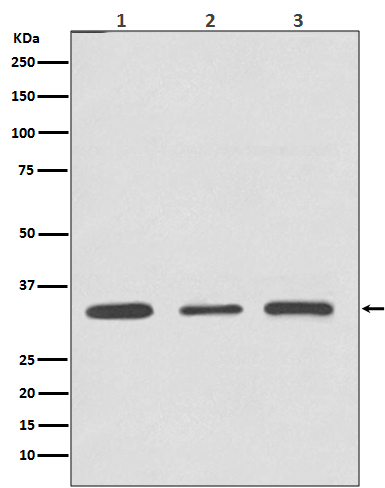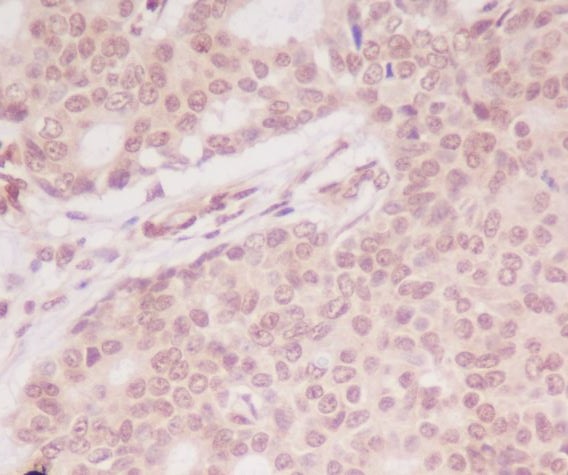

| WB | 1/500-1/1000 | Human,Mouse,Rat |
| IF | 1/20 | Human,Mouse,Rat |
| IHC | 1/50-1/100 | Human,Mouse,Rat |
| ICC | 1/50-1/200 | Human,Mouse,Rat |
| FCM | 咨询技术 | Human,Mouse,Rat |
| Elisa | 咨询技术 | Human,Mouse,Rat |
| Aliases | ATF5; ATFX; Cyclic AMP-dependent transcription factor ATF-5; cAMP-dependent transcription factor ATF-5; Activating transcription factor 5; Transcription factor ATFx |
| Entrez GeneID | 22809 |
| WB Predicted band size | Calculated MW: 31 kDa; Observed MW: 31 kDa |
| Host/Isotype | Rabbit IgG |
| Antibody Type | Primary antibody |
| Storage | Store at 4°C short term. Aliquot and store at -20°C long term. Avoid freeze/thaw cycles. |
| Species Reactivity | Human,Mouse,Rat |
| Immunogen | A synthesized peptide derived from human ATF5 |
| Formulation | Purified antibody in PBS with 0.05% sodium azide. |
+ +
以下是3篇关于ATF5抗体的参考文献及其摘要概括:
1. **文献名称**: "ATF5 regulates the proliferation and survival of human glioblastoma cells"
**作者**: Angelastro JM et al.
**摘要**: 研究利用ATF5抗体检测其在胶质母细胞瘤中的表达,发现ATF5通过调控Bcl-2家族蛋白促进肿瘤细胞存活,抑制其表达可诱导癌细胞凋亡。
2. **文献名称**: "The transcription factor ATF5 is required for terminal differentiation and survival of olfactory sensory neurons"
**作者**: Wang Z et al.
**摘要**: 通过ATF5抗体染色发现,ATF5在嗅感觉神经元分化中起关键作用,其缺失导致神经元发育异常并引发细胞死亡。
3. **文献名称**: "ATF5 maintains cancer stem cell properties by regulating mitochondrial oxidative phosphorylation"
**作者**: Li X et al.
**摘要**: 研究使用ATF5抗体验证其在肿瘤干细胞中的高表达,揭示ATF5通过增强线粒体氧化磷酸化维持干性,成为潜在治疗靶点。
4. **文献名称**: "Targeting ATF5 in cancer: A novel therapeutic approach"
**作者**: Monaco SE et al.
**摘要**: 该文献综述ATF5抗体在多种癌症模型中的应用,提出抑制ATF5可选择性杀伤癌细胞,而对正常细胞影响较小,具有临床转化潜力。
ATF5 (Activating Transcription Factor 5) is a member of the ATF/CREB family of basic leucine zipper (bZIP) transcription factors, which play critical roles in regulating cellular responses to stress, proliferation, and differentiation. ATF5 is widely expressed in various tissues, with high levels observed in the brain, liver, and certain cancer cells. It regulates target genes involved in apoptosis, cell cycle control, and adaptation to metabolic or environmental stressors, such as amino acid deprivation or endoplasmic reticulum (ER) stress.
ATF5 antibodies are essential tools for studying its expression, localization, and function in both physiological and pathological contexts. These antibodies are commonly used in techniques like Western blotting, immunohistochemistry (IHC), immunofluorescence (IF), and chromatin immunoprecipitation (ChIP). Researchers have utilized ATF5 antibodies to explore its role in cancer progression, neurodevelopment, and stem cell maintenance, as well as its potential as a therapeutic target. For example, elevated ATF5 expression has been linked to tumor survival, chemoresistance, and poor prognosis in gliomas and breast cancers.
Due to sequence homology among ATF/CREB family members, antibody specificity is a critical consideration. Validation via knockout controls or siRNA knockdown is often recommended. Commercial ATF5 antibodies are typically raised against epitopes within its N-terminal transactivation or C-terminal regulatory domains. Ongoing research continues to clarify ATF5's context-dependent functions, driving demand for reliable antibodies to dissect its complex roles in health and disease.
×